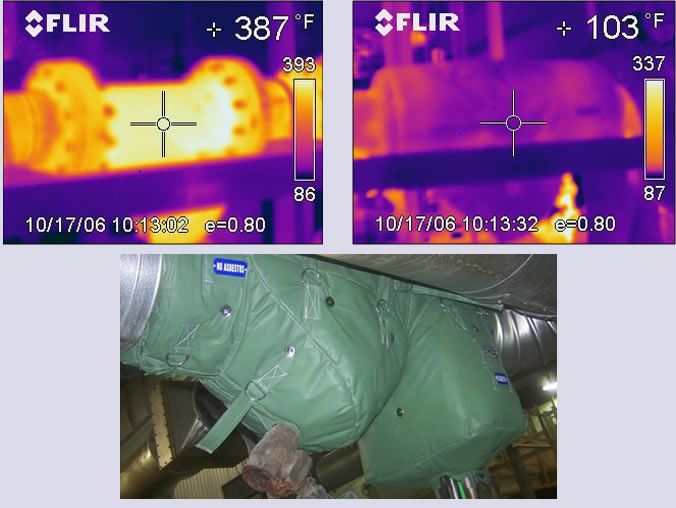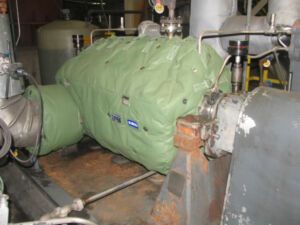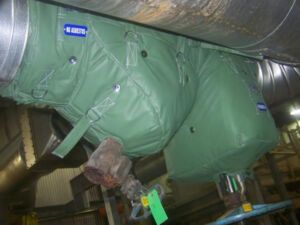ROI with Reusable Insulation
Since 2011, a paper mill has saved $400,000 on a $95,000 investment in reusable Shannon insulation blankets on approximately 400 steam fittings on one of its paper machines. Generally, reusable insulation projects offer economic returns and improve safety. The ‘jacketed’ insulation can be easily removed for maintenance and re-installed with relative ease.
“Reusable insulation pays for itself, and we were able to show that through an energy survey. The return numbers helped our gatekeepers make this more of an economic-driven decision and not so much a budget-driven one.”
It is noteworthy that many facilities are not enthusiastic about insulation projects because they are constrained on expense projects and seldom on capital. It should be noted that most insulation projects are considered expense projects, not capital, if the original insulation was removed for repair work and is now being replaced. Pursuing expense related projects, be it a roofing project, tank or insulation replacement, gets its share of challenges. Managers who focus on economic returns instead of budgets view their expense spend plan more like capital investments. It is important to focus on the ROI with reusable insulation.
The paper mill discussed in this case study generates steam to power its facility. When generating steam, heat (energy) is lost whenever sections of the steam distribution system have lost their insulation. Generally, insulation gets removed in and around areas that tend to spring leaks the most: valves, steam traps and fittings. Sometimes, when these leak-prone areas are repaired the insulation that originally covered them is removed and discarded. This leaves them uncovered and losing valuable energy.
Reusable insulation can be an economical alternative for these applications. For a small upcharge you get an engineered, custom fitted insulation blanket that is well marked, allowing for easy removal and re-installation.
“Reusable insulation pays for itself, and we were able to show that through an energy survey. The return numbers helped our gatekeepers make this more of an economic-driven decision and not so much a budget-driven one,” says the engineering manager for the mill.
A gate valve at the mill wrapped in a Shannon insulation blanket that maintenance crews can easily remove and replace.
The first step for the mill’s engineering manager involved arranging for a free energy survey, which Shannon willingly provides to vet a project.
“Most insulation surveys address pipe and ignore the greatest opportunity, complex valves and fittings,” says Frank Kovacs, president of Shannon. “To correctly design and fit reusable insulation, a manufacturer needs an education in steam process systems and energy survey fundamentals.”
Shannon’s survey included analysis of 1,909 steam fittings and heat-loss calculations detailing thermal conductivity, insulation thickness, operating costs and fuel costs. The survey, among other things, showed the plant had a $500,000 energy savings opportunity if they insulated bare fittings.
The mill’s energy leader used the Shannon heat-loss numbers and a simple IRR calculation (.7176 x Annual Savings/Investment Cost) to define the economics of investing in reusable blankets ( the ROI with reusable insulation ). While there were savings across every type of fitting, the energy leader strategically selected the opportunities of highest return and presented them to the gatekeepers and leadership team. He also looked at where certain points of insulation might meet a safety requirement or improve the reliability of a piece of equipment.
“Our energy leader reviewed the survey with key people in the plant who added the relevant parts to their spend plans for the following year,” recalls the energy manager. “In some cases, the decision-makers executed the jobs immediately because there were benefits for plant safety or equipment operations.”
The quality of the insulation and the impressive results on the early installations led to other areas of the plant to follow suit. One such area was the backside of one of the plant’s paper machines. The steam and condensate lines were difficult to keep insulated due to the need to remove the insulation from the many small-bore lines when doing maintenance. The Shannon removeable covers were custom fitted and have a tag with the CAT ID on them for reorder if ever needed. An unexpected benefit was that operators noticed a significant drop in the air temperature on the backside when the insulating work was completed. Lower temps improved their work environment and reduced the risk of heat-related illness. You can tell operators and maintenance techs value the insulation as it has remained in place despite numerous removals for maintenance activity over the years. As of this writing, the mill has racked up a nearly 300-percent ROI with reusable insulation, which is the very definition of a capital expense: something a business incurs to create a benefit in the future.
A before-after photo of an energy survey using infrared measurement validates the benefits of reusable insulation.
“Reusable insulation blankets are also a green concept,” says Tim Janos, director of special projects for the Association of Energy Engineers, “because maintenance workers will throw out insulation if it’s difficult to reinstall. I’ve seen reusable blankets in place for 30 years. Think of the energy saved from a $500 blanket over 30 years.”




